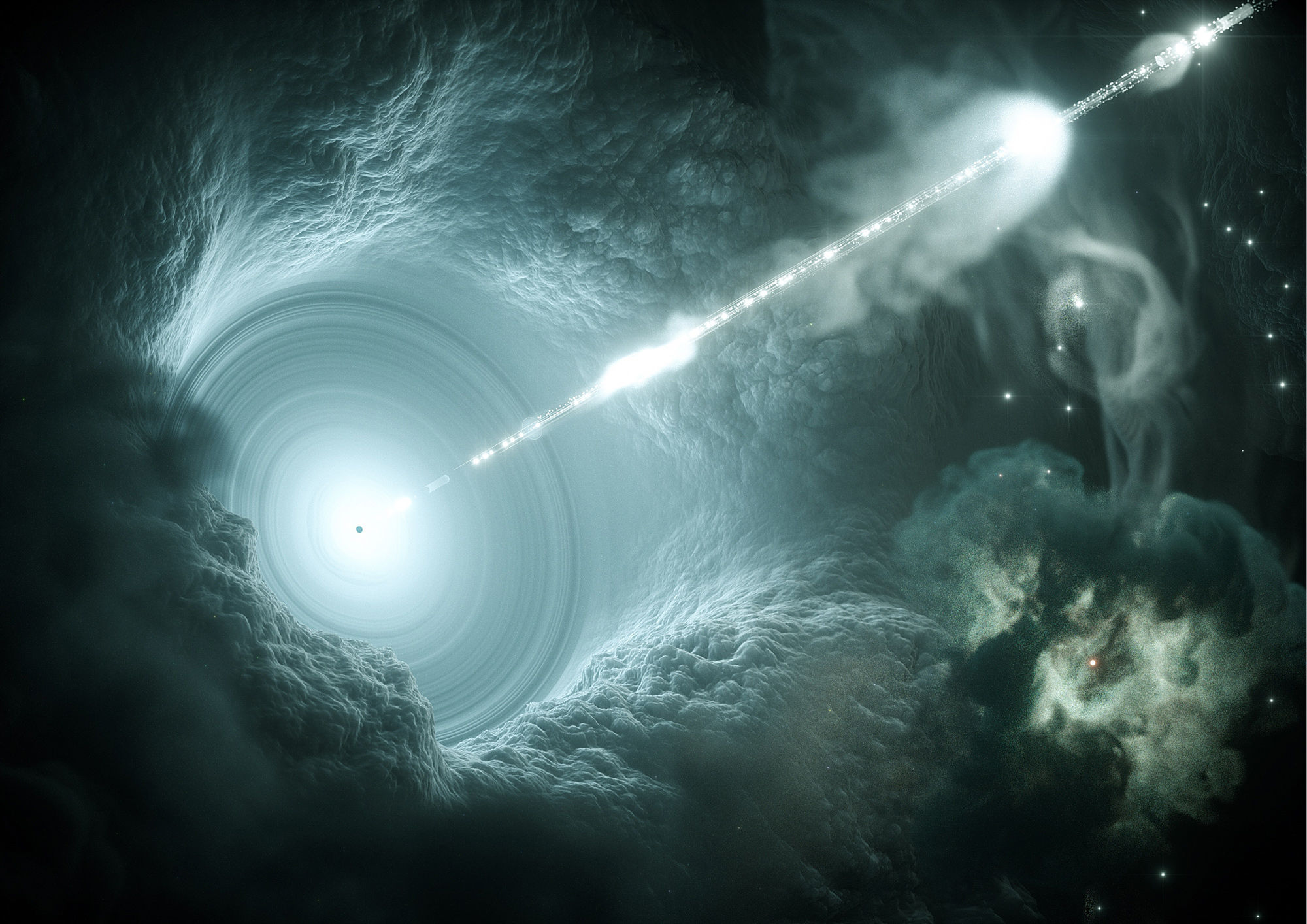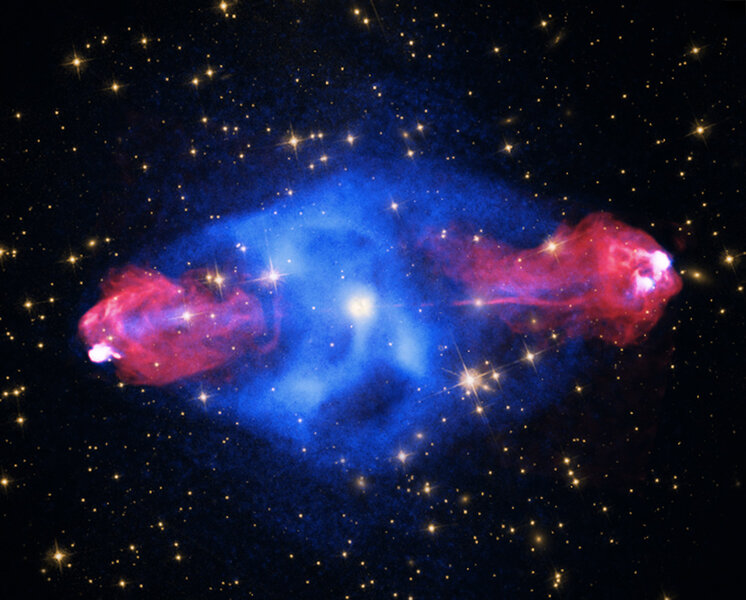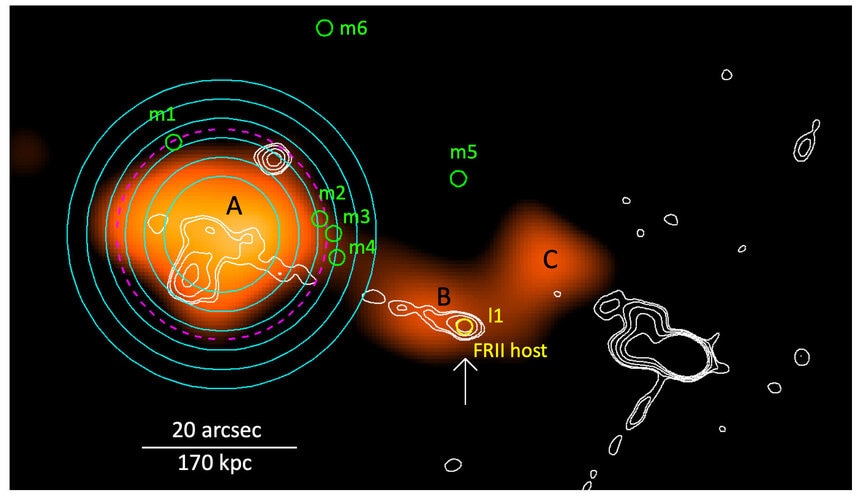Create a free profile to get unlimited access to exclusive videos, sweepstakes, and more!
The wind from a galaxy's supermassive black hole helps make stars… in other galaxies

Supermassive black holes are true monsters of the Universe. From millions to even billions of times the mass of the Sun, there's one in the very center of every big galaxy in the cosmos, and in fact each galaxy itself formed and grew along with its black hole; they affect each other profoundly. As matter falls onto the black hole it falls into an accretion disk, heats up, and emits huge amounts of energy and can also blow a fierce wind of material back into the galaxy (we call such galaxies with actively feeding supermassive black holes active galaxies). This wind can push away gas and dust that would otherwise fall onto the black hole, regulating its growth.
Under some conditions this wind can also compress the gas in the galaxy, which can increase the number of stars forming in the galaxy. But too much wind and the gas is blown right out of the galaxy. Even at some levels in between, it can heat the gas up enough that star formation is much harder. It's like a pressure valve in the galaxy.
This is how it usually works, at least. Astronomers have found a compact group of galaxies clustered around an active galaxy, and that central galaxy's black hole is so powerful it's blowing a wind that's causing star formation in the galaxies around it!
That's amazing, and the first time it's ever been seen.
And it was all found by accident! The astronomers were actually observing a different active galaxy (a quasar) at the vast distance of 12.8 billion light years*. They saw a tight little knot of galaxies in the same field of view, which caught their attention. This group is about 10 billion light years away from us, so in the foreground. The central galaxy in the group is clearly active, and has a supermassive black hole in its core that's probably about 30 million times the mass of the Sun, so a middleweight as supermassive ones go.
Surrounding it are at least eight other galaxies, and probably quite a few more too dim to see. Most are within about 1.3 million light years of the central galaxy, making this group smaller than our own Local Group (which contains the Milky Way, Andromeda, and a couple of dozen smaller galaxies).
The galaxies in the group are unusual in that they are compact and very blue, indicating strong star formation rates in them. Measuring their light, the astronomers calculate they are forming stars from 8–60 solar masses a year, far faster than the Milky Way does (we form about one solar mass worth of stars per year). So these are extremely fecund galaxies.
When they observed this group with the Chandra X-ray Observatory, they found a lot of X-rays coming from it. The central galaxy's black hole is blasting them out, and this is due to the super-hot accretion disk of material surrounding it. But it's also creating what's called a jet, a beam of matter screaming away from it, launched into space by the heat and magnetic fields of the accretion disk. In some active galaxies these jets can be hundreds of thousands of light years long. Longer. And in this case, the jet is well over a million light years long.
The jet is so energetic it creates a shock wave in the thin material in between the galaxies, a cosmic sonic boom that heats that material up to millions of degrees, where it can emit X-rays as well. This creates a diffuse cloud of X-ray emission around the jet… and that's where this gets interesting. Four of the strongest star-forming galaxies in that group lie right at the edge of this diffuse cloud, along an arc about 400,000 light years from center of the diffuse cloud.
Given they're all at the edge of that powerful shock wave, and all forming stars at accelerated rates, the astronomers conclude this is all connected. The shock wave from the jet is likely slamming into those galaxies, compressing the colder material inside them, and this material then collapses to form stars. While jets from active galaxies have been seen hitting other galaxies before, this is the first time it's been seen to affect what's going on inside the galaxies, specifically the birth of stars. And it's happening at huge distances from the black hole!
This sort of thing has been seen internally in a galaxy before, where the jet increases star formation in the supermassive black hole's galaxy host. But even then there's a mild rate of star formation increase (about 30% or so) and it's close in (some tens of thousands of light years), and the jet isn't very powerful. In this case, the scale is a lot bigger: More powerful jet, more distant galaxies, much higher star formation rate (up to five times what you'd expect for galaxies in the early Universe).
Like I said, we know that these supermassive black holes can regulate the growth of their host galaxies, but it's usually in a negative way. That's probably true here too, with such a powerful jet in that galaxy. But for the galaxies nearby, it's a positive effect, with stars being born at a furious rate in those neighbors.
You might think of black holes as unmitigated destroyers of everything around them. But here the exact opposite is true. It's helping make stars, perhaps tens or hundreds of millions of them over time. So yeah, black holes tend to tear things up around them, and create chaos, but at least in this case it's doing its best to create order, too.
*Technically, it took 12.8 billion years for its light to reach us. The Universe has been expanding all that time, so if you want to think about where it is "now," it's nearly 30 billion light years away.





























